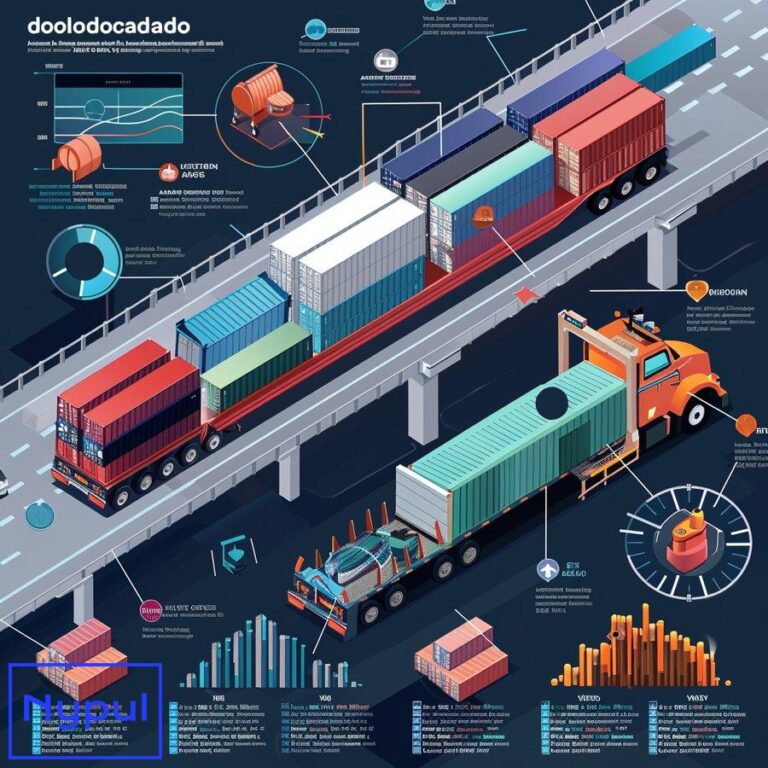What Is the Intermodal Transportation Strategy
How does an intermodal transportation strategy work?
An intermodal transportation strategy leverages multiple modes of transport to move goods efficiently from origin to destination. This approach combines the strengths of different transportation methods, typically involving a combination of truck, rail, and sometimes sea or air freight.
The core principle of intermodal transportation is the use of standardized containers. These containers can be easily transferred between different modes of transport without the need to unpack and repack the cargo. This seamless transition between modes is the key to the strategy’s efficiency.
The Intermodal Process
Initial Drayage: The journey begins with a truck picking up a loaded container from the shipper’s location. This short-haul trucking, known as drayage, brings the container to an intermodal terminal.
Rail Transport: At the terminal, the container is transferred onto a train. Rail transport forms the long-haul portion of the journey, covering hundreds or thousands of miles efficiently.
Final Drayage: Once the train reaches the destination terminal, another truck picks up the container for final delivery to the consignee.
This process can be visualized in the following table:
| Stage | Mode | Description |
|---|---|---|
| 1 | Truck | Initial drayage from shipper to rail terminal |
| 2 | Rail | Long-haul transport between terminals |
| 3 | Truck | Final drayage from rail terminal to consignee |
Key Players in Intermodal Transportation
Shippers: Businesses that need to transport goods.
Drayage Providers: Trucking companies specializing in short-haul container transport.
Rail Carriers: Companies operating the rail networks and trains.
Intermodal Marketing Companies (IMCs): Intermediaries that coordinate intermodal shipments.
Terminal Operators: Entities managing the intermodal facilities where mode transfers occur.
Benefits of the Intermodal Strategy
The intermodal transportation strategy offers several advantages:
Cost Efficiency: By utilizing rail for the long-haul portion, intermodal can be more cost-effective than long-distance trucking.
Environmental Sustainability: Rail transport is generally more fuel-efficient than trucking, reducing the carbon footprint of shipments.
Capacity: Intermodal helps address truck driver shortages by relying on rail for long distances.
Security: Containers remain sealed throughout the journey, reducing the risk of theft or damage.
Flexibility: The strategy combines the door-to-door convenience of trucking with the long-distance efficiency of rail.
Considerations for Implementation
While intermodal transportation offers numerous benefits, it’s not suitable for every shipment. Factors to consider include:
Distance: Intermodal is typically most cost-effective for distances over 500 miles.
Volume: The strategy works best for consistent, high-volume shipments.
Time Sensitivity: While generally reliable, intermodal transit times can be longer than direct trucking.
Product Type: Some goods, like perishables or hazardous materials, may have special requirements that affect intermodal suitability.
By understanding these elements, businesses can determine if an intermodal transportation strategy aligns with their logistics needs and goals.
What are the key benefits of implementing an intermodal strategy?

Implementing an intermodal transportation strategy offers numerous advantages for businesses seeking to optimize their supply chain operations. These benefits span various aspects of logistics, from cost savings to environmental impact reduction.
Cost Reduction
One of the primary benefits of intermodal transportation is its potential for significant cost savings. By leveraging the efficiency of rail for long-haul portions of the journey, companies can reduce their overall transportation expenses.
Fuel Efficiency: Rail transport is approximately 3-4 times more fuel-efficient than trucking on a per-ton-mile basis. This translates directly into lower fuel costs for long-distance shipments.
Labor Costs: With rail handling the bulk of the journey, fewer driver hours are required, mitigating the impact of driver shortages and reducing labor costs.
Economies of Scale: Intermodal allows for the consolidation of multiple shipments onto a single train, spreading fixed costs across a larger volume of goods.
Environmental Sustainability
Intermodal transportation significantly reduces the carbon footprint of freight movement, aligning with corporate sustainability goals and regulatory requirements.
Reduced Emissions: A single intermodal train can replace hundreds of trucks, dramatically cutting greenhouse gas emissions. On average, intermodal transportation produces 60% fewer carbon dioxide emissions compared to over-the-road trucking for the same distance.
Energy Efficiency: The superior fuel efficiency of rail translates directly into lower energy consumption per unit of freight moved.
Congestion Reduction: By shifting long-haul freight to rail, intermodal helps reduce highway congestion, indirectly contributing to lower emissions from passenger vehicles.
Capacity and Scalability
Intermodal transportation offers solutions to capacity constraints in the trucking industry while providing scalability for growing businesses.
Driver Shortage Mitigation: With the ongoing truck driver shortage, intermodal allows companies to move large volumes of freight with fewer drivers.
Equipment Utilization: Intermodal containers can be quickly transferred between modes, improving equipment turnaround times and utilization rates.
Flexible Capacity: During peak seasons or periods of growth, businesses can more easily scale up their transportation capacity without significant capital investment in trucks or drivers.
Safety and Security
The intermodal approach enhances the safety and security of freight transportation in several ways:
Reduced Handling: Goods remain in the same container throughout the journey, minimizing the risk of damage or theft during transfers.
Lower Accident Rates: Rail transportation has a lower accident rate compared to long-haul trucking, reducing the risk of cargo loss or damage.
Enhanced Tracking: Modern intermodal systems often incorporate advanced tracking technologies, providing real-time visibility of shipments throughout their journey.
Reliability and Consistency
While transit times may be slightly longer than direct trucking in some cases, intermodal transportation often offers greater consistency and reliability.
Weather Resilience: Rail transportation is less affected by adverse weather conditions compared to long-haul trucking.
Predictable Schedules: Train schedules are generally more consistent and less prone to delays caused by traffic or driver hours-of-service regulations.
Reduced Congestion Impact: By avoiding congested highways, intermodal shipments can maintain more consistent transit times, especially in urban areas.
Strategic Advantages
Implementing an intermodal strategy can provide businesses with several strategic benefits:
Market Reach: Intermodal networks can extend a company’s reach into new markets without the need for significant investment in trucking resources.
Risk Mitigation: Diversifying transportation modes helps protect against disruptions in any single mode, enhancing supply chain resilience.
Competitive Advantage: The cost savings and environmental benefits of intermodal can be leveraged to gain a competitive edge in price-sensitive markets or with environmentally conscious customers.
The following table summarizes the key benefits of implementing an intermodal strategy:
| Benefit Category | Description | Impact |
|---|---|---|
| Cost Reduction | Lower fuel and labor costs | 10-30% savings on long-haul routes |
| Environmental Sustainability | Reduced carbon emissions | Up to 60% lower CO2 emissions |
| Capacity and Scalability | Mitigates driver shortages | Potential for 3x capacity increase |
| Safety and Security | Lower accident rates, reduced handling | Up to 50% reduction in cargo claims |
| Reliability | Consistent transit times | 95%+ on-time performance |
| Strategic Advantages | Extended market reach, risk mitigation | Enhanced competitive positioning |
By carefully considering these benefits, businesses can make informed decisions about incorporating intermodal transportation into their logistics strategies, potentially realizing significant improvements in efficiency, sustainability, and overall supply chain performance.
How can businesses assess their need for intermodal transportation?
Assessing the need for intermodal transportation requires a comprehensive analysis of a company’s logistics operations, shipping patterns, and business objectives. This evaluation process helps determine whether intermodal solutions can provide tangible benefits and align with the organization’s strategic goals.
Shipping Volume and Frequency Analysis
The first step in assessing intermodal suitability is to examine current shipping volumes and patterns.
High-Volume Lanes: Identify shipping lanes with consistent, high-volume freight movement. Intermodal typically becomes more cost-effective as volume increases.
Shipment Frequency: Evaluate the regularity of shipments. Consistent, scheduled freight is well-suited for intermodal transportation.
Seasonal Fluctuations: Analyze seasonal variations in shipping volume. Intermodal can provide scalable capacity during peak periods.
Distance Evaluation
The distance of shipments plays a crucial role in determining intermodal viability.
Long-Haul Routes: Focus on routes over 500 miles. Intermodal generally becomes more competitive at these distances.
Origin-Destination Pairs: Identify frequently used origin-destination pairs that align with existing intermodal networks.
Cross-Border Shipments: Assess international shipments, as intermodal can offer advantages in customs clearance and border crossing efficiency.
Cost Analysis
A detailed cost comparison between current transportation methods and potential intermodal solutions is essential.
Current Transportation Costs: Calculate the total cost of existing transportation methods, including fuel, labor, equipment, and accessorial charges.
Intermodal Cost Projection: Estimate potential intermodal costs, considering drayage, rail fees, and any additional handling charges.
Long-Term Cost Trends: Analyze how factors like fuel prices and driver wages might impact future costs for both trucking and intermodal options.
Transit Time and Service Level Requirements
Evaluate whether intermodal transit times align with business needs and customer expectations.
Time-Sensitive Shipments: Identify which shipments have strict delivery deadlines that may not be compatible with intermodal transit times.
Service Level Agreements: Review customer agreements to ensure intermodal transit times can meet contractual obligations.
Inventory Management: Consider how longer transit times might impact inventory levels and carrying costs.
Product Characteristics
The nature of the products being shipped can influence intermodal suitability.
Product Value: High-value goods may benefit from the enhanced security of intermodal transportation.
Perishability: Assess whether temperature-sensitive or perishable goods can be accommodated within intermodal transit times and equipment.
Hazardous Materials: Determine if any shipments involve hazardous materials and whether they can be transported via intermodal networks.
Infrastructure and Network Accessibility
Evaluate the availability and proximity of intermodal infrastructure.
Proximity to Intermodal Terminals: Assess the distance between shipping origins/destinations and the nearest intermodal terminals.
Drayage Requirements: Calculate potential drayage costs and transit times to and from intermodal facilities.
Network Coverage: Review intermodal network maps to ensure coverage aligns with key shipping lanes.
Environmental Impact Assessment
Consider how intermodal transportation aligns with sustainability goals.
Carbon Footprint Calculation: Compare the estimated carbon emissions of current transportation methods with potential intermodal solutions.
Regulatory Compliance: Assess how intermodal adoption might help meet current or future environmental regulations.
Corporate Sustainability Goals: Evaluate how intermodal aligns with broader corporate sustainability initiatives.
Operational Readiness
Assess the organization’s ability to integrate intermodal transportation into existing operations.
IT Systems Compatibility: Evaluate whether current transportation management systems can accommodate intermodal shipments.
Staff Training Needs: Identify any training requirements for staff to effectively manage intermodal transportation.
Partner Relationships: Assess existing relationships with carriers and logistics providers to determine their intermodal capabilities.
Risk Assessment
Consider potential risks and challenges associated with adopting intermodal transportation.
Service Disruptions: Evaluate the impact of potential rail service disruptions or labor issues on supply chain reliability.
Equipment Availability: Assess the risk of container shortages or imbalances in key markets.
Market Volatility: Consider how changes in fuel prices or economic conditions might affect the comparative advantage of intermodal over time.
To facilitate this assessment process, businesses can use the following decision matrix:
| Assessment Criteria | Weight | Current Method Score (1-5) | Intermodal Score (1-5) | Weighted Intermodal Score |
|---|---|---|---|---|
| Cost Efficiency | 25% | |||
| Transit Time | 20% | |||
| Service Reliability | 15% | |||
| Environmental Impact | 15% | |||
| Operational Fit | 15% | |||
| Risk Factors | 10% | |||
| Total | 100% |
By completing this matrix with scores based on the detailed assessment of each criterion, businesses can quantify the potential benefits of intermodal transportation. A higher total weighted score for intermodal compared to the current method would indicate a strong case for adoption.
This comprehensive assessment approach enables businesses to make informed decisions about incorporating intermodal transportation into their logistics strategy, ensuring that any transition aligns with operational needs, financial objectives, and long-term strategic goals.
What are the critical components of an effective intermodal network?
An effective intermodal network is a complex system comprising various interconnected components. Each element plays a crucial role in ensuring the smooth, efficient, and reliable movement of goods across multiple transportation modes. Understanding these critical components is essential for businesses looking to leverage intermodal transportation effectively.

Intermodal Terminals
Intermodal terminals serve as the vital hubs where cargo transfers between different modes of transportation occur.
Location: Strategically positioned near major transportation corridors and population centers.
Equipment: Equipped with cranes, lifts, and other machinery for efficient container handling.
Capacity: Sufficient space and throughput capacity to handle peak volumes without significant delays.
Connectivity: Well-connected to road and rail networks, with easy access for trucks and trains.
Rail Infrastructure
The backbone of long-distance intermodal transportation, rail infrastructure is crucial for efficient and cost-effective freight movement.
Track Network: Extensive and well-maintained rail lines connecting major economic centers.
Double-Stack Capability: Clearances allowing for double-stacked containers, maximizing capacity and efficiency.
Intermodal-Specific Railcars: Specialized flatcars designed for easy loading and unloading of containers.
Signaling and Control Systems: Advanced systems ensuring safe and efficient train movements.
Drayage Operations
Drayage provides the critical first and last-mile connections in the intermodal chain.
Truck Fleets: Sufficient number of trucks capable of handling intermodal containers.
Driver Availability: Adequate pool of qualified drivers familiar with intermodal operations.
Dispatch Systems: Efficient systems for coordinating pickups and deliveries with terminal operations.
Regulatory Compliance: Adherence to local, state, and federal regulations governing drayage operations.
Container Equipment
Standardized containers are the cornerstone of intermodal transportation, enabling seamless transfers between modes.
Container Types: Variety of container sizes and types to accommodate different cargo needs (e.g., 20-foot, 40-foot, refrigerated).
Maintenance and Repair: Regular inspection and maintenance to ensure container integrity and safety.
Tracking Technology: GPS and other tracking systems for real-time visibility of container locations.
Container Management: Efficient systems for managing container inventory and repositioning.
Information Technology Systems
Advanced IT systems are essential for coordinating the complex movements and transactions in intermodal networks.
Transportation Management Systems (TMS): Software for planning, executing, and optimizing intermodal shipments.
Electronic Data Interchange (EDI): Standardized formats for exchanging shipment information between parties.
Visibility Platforms: Systems providing real-time tracking and status updates for shipments.
Booking and Reservation Systems: Platforms for securing capacity on trains and at terminals.
Customs and Border Systems
For international shipments, efficient customs processes are critical to intermodal success.
Pre-Clearance Programs: Systems allowing for advance submission of customs documentation.
Automated Customs Systems: Electronic platforms for processing customs declarations and payments.
Inspection Facilities: Adequate infrastructure for customs inspections at key border crossings and ports.
Compliance Management: Systems for ensuring adherence to import/export regulations and documentation requirements.
Intermodal Service Providers
A network of service providers is necessary to coordinate and execute intermodal movements.
Intermodal Marketing Companies (IMCs): Intermediaries specializing in arranging intermodal transportation.
Asset-Based Providers: Rail carriers and trucking companies with intermodal-specific equipment and services.
Third-Party Logistics Providers (3PLs): Companies offering comprehensive logistics services, including intermodal solutions.
Freight Forwarders: Specialists in arranging international shipments, often utilizing intermodal services.
Labor and Workforce
Skilled personnel are essential at every stage of the intermodal process.
Terminal Operators: Staff trained in efficient and safe container handling.
Train Crews: Qualified personnel forLabor and Workforce
Skilled personnel are essential at every stage of the intermodal process.
Terminal Operators: Staff trained in efficient and safe container handling.
Train Crews: Qualified personnel for operating trains and ensuring safe transport.
Drayage Drivers: Experienced drivers familiar with intermodal logistics and regulations.
IT Specialists: Technicians to maintain and optimize information technology systems supporting intermodal operations.
Collaboration and Partnerships
Building strong relationships among various stakeholders is critical for an effective intermodal network.
Shippers and Carriers: Collaboration between shippers and carriers ensures that capacity is aligned with demand.
Intermodal Providers: Partnerships with IMCs, 3PLs, and freight forwarders enhance service offerings and capabilities.
Regulatory Authorities: Open communication with regulatory bodies helps ensure compliance and smooth operations.
The following table summarizes the critical components of an effective intermodal network:
| Component | Description | Importance |
|---|---|---|
| Intermodal Terminals | Hubs for cargo transfer | Essential for efficient mode switching |
| Rail Infrastructure | Extensive track network | Backbone for long-distance transport |
| Drayage Operations | First/last-mile connections | Critical for overall supply chain efficiency |
| Container Equipment | Standardized containers | Enables seamless transfers between modes |
| Information Technology Systems | Software for coordination | Enhances visibility and efficiency |
| Customs and Border Systems | Efficient customs processes | Vital for international shipments |
| Intermodal Service Providers | Coordinators of movements | Ensure smooth execution of intermodal logistics |
| Labor and Workforce | Skilled personnel at all levels | Essential for operational success |
| Collaboration and Partnerships | Strong stakeholder relationships | Enhances service quality and responsiveness |
By understanding these components, businesses can effectively design, implement, and manage their intermodal transportation strategies, ensuring optimal performance across their logistics networks.
How can companies optimize their intermodal operations?
Optimizing intermodal operations involves a systematic approach to improving efficiency, reducing costs, and enhancing service levels. Companies can adopt several strategies to streamline their intermodal processes while maximizing the benefits of this transportation method.

Data-Driven Decision Making
Utilizing data analytics is crucial for optimizing intermodal operations. Companies should focus on collecting, analyzing, and applying data to drive improvements.
Performance Metrics Tracking: Establish key performance indicators (KPIs) to monitor transit times, costs, on-time delivery rates, and customer satisfaction.
Predictive Analytics: Leverage historical data to forecast demand patterns, enabling better capacity planning and resource allocation.
Route Optimization Tools: Use software solutions that analyze traffic patterns, weather conditions, and other variables to identify the most efficient routes for drayage operations.
Enhancing Coordination Among Stakeholders
Effective communication and collaboration among all stakeholders in the intermodal supply chain are essential for optimizing operations.
Integrated Planning Systems: Implement integrated transportation management systems (TMS) that facilitate real-time communication between shippers, carriers, terminal operators, and drayage providers.
Regular Stakeholder Meetings: Schedule regular meetings or updates with all parties involved in the supply chain to discuss performance metrics, address issues, and share best practices.
Collaborative Problem-Solving: Encourage a culture of collaboration where stakeholders work together to identify challenges and develop solutions that benefit the entire network.
Improving Terminal Efficiency
Optimizing terminal operations is vital for minimizing delays during mode transfers. Companies should focus on the following areas:
Container Handling Technology: Invest in advanced equipment such as automated cranes or straddle carriers that improve loading/unloading speed at terminals.
Process Standardization: Develop standardized procedures for container handling to reduce variability in operations and improve overall efficiency.
Real-Time Tracking Systems: Implement tracking technologies that provide real-time updates on container locations within terminals to streamline scheduling and reduce wait times.
Streamlining Drayage Operations
Efficient drayage operations are critical for ensuring timely pickups and deliveries. Companies can optimize these processes through:
Dedicated Drayage Fleets: Consider using dedicated fleets specifically for intermodal drayage to enhance reliability and reduce delays associated with mixed loads.
Dynamic Dispatching Systems: Utilize technology that allows for dynamic dispatching based on real-time conditions such as traffic or weather disruptions.
Driver Training Programs: Invest in training programs focused on intermodal-specific practices to ensure drivers are well-versed in handling containers safely and efficiently.
The following table outlines strategies for optimizing intermodal operations:
| Optimization Area | Strategies |
|---|---|
| Data-Driven Decision Making | Performance metrics tracking, predictive analytics, route optimization tools |
| Coordination Among Stakeholders | Integrated planning systems, regular stakeholder meetings, collaborative problem-solving |
| Terminal Efficiency | Container handling technology, process standardization, real-time tracking systems |
| Drayage Operations | Dedicated drayage fleets, dynamic dispatching systems, driver training programs |
By implementing these optimization strategies across various aspects of their intermodal operations, companies can achieve significant improvements in efficiency, cost-effectiveness, and service quality.
What challenges might arise in intermodal transportation and how can they be addressed?

While intermodal transportation offers numerous benefits, it also presents a unique set of challenges that businesses must navigate. Identifying these challenges early on allows companies to develop proactive strategies to mitigate risks and ensure smooth operations throughout the supply chain.
Complexity of Coordination
Intermodal transportation involves multiple stakeholders—shippers, carriers, terminal operators—which can lead to coordination challenges.
Solution: Establish clear communication protocols among all parties involved. Implement integrated transportation management systems (TMS) that facilitate real-time information sharing about shipment status, schedules, and delays. Regular meetings can also help align objectives among stakeholders.
Transit Time Variability
Transit times may vary significantly due to factors such as rail schedules or terminal congestion. This variability can impact delivery commitments made to customers.
Solution: Set realistic expectations with customers regarding transit times based on historical performance data. Use predictive analytics tools to identify potential delays early in the process so alternative arrangements can be made if necessary.
Infrastructure Limitations
Not all regions have adequate infrastructure to support intermodal transportation effectively. Limited access to terminals or rail networks can hinder service availability.
Solution: Conduct thorough market assessments before entering new regions. Engage with local governments or infrastructure developers to advocate for improvements that will enhance access to intermodal facilities.
The following table summarizes common challenges in intermodal transportation along with potential solutions:
| Challenge | Description | Solution |
|---|---|---|
| Complexity of Coordination | Multiple stakeholders create coordination issues | Clear communication protocols; integrated TMS |
| Transit Time Variability | Unpredictable transit times affect delivery schedules | Set realistic expectations; use predictive analytics |
| Infrastructure Limitations | Limited access hinders service availability | Market assessments; advocate for infrastructure improvements |
How can intermodal performance be measured and improved?
Measuring the performance of intermodal transportation is essential for identifying areas of improvement and ensuring operational efficiency. Businesses should adopt a systematic approach to performance measurement that includes key metrics tailored specifically to their logistics objectives.
Key Performance Indicators (KPIs)
Establishing relevant KPIs is crucial for effectively measuring intermodal performance. Some important KPIs include:
-
On-Time Delivery Rate (OTD): The percentage of shipments delivered on or before the scheduled date.
-
Transit Time Variability (TTV): The average difference between expected transit time versus actual transit time.
-
Cost per Shipment (CPS): The total cost incurred divided by the number of shipments transported via intermodal methods.
-
Container Utilization Rate (CUR): The percentage of container capacity utilized during transport.
-
Customer Satisfaction Score (CSS): Feedback from customers regarding their satisfaction with delivery timeliness and condition upon arrival.
Continuous Improvement Processes
Once KPIs are established, businesses should implement continuous improvement processes based on performance data analysis:
-
Regular Performance Reviews: Schedule periodic reviews of KPIs with stakeholders to assess progress toward goals.
-
Root Cause Analysis (RCA): When performance falls short of targets, conduct RCA sessions to identify underlying issues contributing to poor results.
-
Benchmarking Against Industry Standards: Compare performance metrics against industry benchmarks or competitors to identify areas where improvements are needed.
-
Employee Training Programs: Invest in ongoing training programs focused on best practices in logistics management specific to intermodal transportation.
The following table outlines key performance indicators along with their significance:
| KPI | Description | Importance |
|---|---|---|
| On-Time Delivery Rate | Percentage of shipments delivered on time | Indicates reliability of service |
| Transit Time Variability | Difference between expected vs actual transit times | Highlights efficiency issues |
| Cost per Shipment | Total cost divided by number of shipments | Measures cost-effectiveness |
| Container Utilization Rate | Percentage of container capacity utilized | Assesses operational efficiency |
| Customer Satisfaction Score | Feedback from customers regarding delivery experience | Reflects service quality |
By systematically measuring performance through these KPIs while engaging in continuous improvement efforts based on data analysis results will enable companies engaged in intermodal transportation not only enhance their operational effectiveness but also boost customer satisfaction levels over time.
What role does technology play in enhancing intermodal transportation?
Technology plays a pivotal role in enhancing the efficiency, reliability, and visibility of intermodal transportation. By integrating advanced technologies into various aspects of logistics processes, companies can streamline operations while improving decision-making capabilities across their supply chains.
Tracking Technologies
Real-time tracking technologies are essential for providing visibility into shipment status throughout the entire journey:
-
GPS Tracking Systems: Enable shippers to monitor container locations in real time using satellite-based navigation systems.
-
RFID Tags: Radio-frequency identification tags can be attached to containers or pallets allowing automated tracking without manual scanning.
-
Mobile Applications: Provide customers with access to shipment status updates via smartphones or tablets enhancing transparency throughout the shipping process.
Transportation Management Systems (TMS)
A robust TMS integrates various functions related to planning execution monitoring within an organization’s logistics framework:
-
Route Optimization: Advanced algorithms analyze traffic patterns weather conditions allowing companies optimize routes dynamically based on current circumstances.
-
Load Planning: TMS solutions help maximize container utilization by suggesting optimal load configurations based on product dimensions weight constraints.
-
Performance Reporting: Automated reporting features generate insights into key performance indicators enabling informed decision-making around operational improvements over time.
Data Analytics
Leveraging data analytics enhances decision-making capabilities across multiple dimensions within an organization’s supply chain:
-
Predictive Analytics: Historical data combined with machine learning algorithms predict future demand trends helping businesses proactively adjust capacity planning accordingly.
-
Cost Analysis Tools: Analyzing costs associated with different modes helps identify opportunities where switching between modes could yield savings without sacrificing service levels.
-
Customer Insights: Analyzing customer feedback trends reveals areas requiring attention improving overall satisfaction rates over time leading repeat business opportunities down the line.
Automation Technologies
Automation technologies streamline various processes within an organization’s logistics framework reducing manual intervention while increasing accuracy overall:
-
Automated Container Handling: Robotic systems equipped at terminals expedite loading/unloading processes minimizing dwell times significantly improving throughput rates overall.
-
Self-Service Kiosks: Allow shippers/receivers check-in/out containers independently reducing wait times associated traditional paperwork processes enhancing customer experience overall.
The following table summarizes key technological advancements enhancing intermodal transportation along with their benefits:
| Technology | Description | Benefits |
|---|---|---|
| Tracking Technologies | Real-time visibility tools | Improved shipment transparency |
| Transportation Management Systems (TMS) | Integrated software solutions | Enhanced route optimization & load planning |
| Data Analytics | Tools leveraging historical data | Informed decision-making & proactive planning |
| Automation Technologies | Robotics & self-service solutions | Increased efficiency & reduced manual errors |
By leveraging these technological advancements effectively companies engaged within an increasingly competitive landscape will not only enhance operational efficiencies but also deliver superior service quality ultimately driving growth opportunities moving forward!
How can businesses develop a tailored intermodal strategy?
Developing a tailored intermodal strategy requires a comprehensive understanding of a company’s unique logistics needs combined with careful consideration of available resources market dynamics regulatory requirements among other factors influencing successful implementation over time. Follow these steps when crafting an effective customized approach towards adopting this versatile mode of freight transport!
Assess Current Logistics Operations
Begin by conducting an assessment of existing logistics operations focusing on shipping volumes distances costs transit times among other relevant factors influencing overall effectiveness:
-
Volume Analysis: Identify lanes where high volumes exist suitable candidates transitioning towards utilizing an integrated multi-modal approach effectively over time.
-
Cost Assessment: Analyze current transportation costs comparing them against potential savings achievable through adopting an inter-modal framework identifying specific areas needing attention moving forward.
Define Objectives
Clearly define objectives guiding your tailored strategy ensuring alignment across organizational goals while addressing specific pain points identified during assessments above:
-
Cost Reduction Goals: Establish target savings percentages achievable through transitioning towards more efficient modes like rail freight alongside traditional trucking options available today!
-
Service Level Expectations: Set realistic expectations around delivery timelines ensuring they align closely customer requirements maintaining satisfaction levels throughout every engagement!
Partner Selection
Select appropriate partners who possess expertise within various aspects related directly towards facilitating successful implementation across different components integral towards achieving desired outcomes effectively!
-
Carrier Relationships: Build strong relationships with reliable carriers capable providing seamless transitions between modes ensuring minimal disruptions occur throughout entire journey!
-
Technology Providers: Engage technology vendors offering advanced solutions designed specifically cater needs associated managing complex multi-modal networks enabling efficient coordination among all parties involved!
Implementation Plan
Create a detailed implementation plan outlining specific steps required transitioning from current state towards desired future state incorporating necessary changes identified previously along way!
-
Pilot Programs: Start small by launching pilot programs testing new processes before scaling up across broader networks reducing risks associated larger rollouts!
-
Training Initiatives: Invest resources into training employees familiarizing them best practices surrounding multi-modal logistics enhancing overall competency levels throughout organization!
-
Continuous Monitoring & Improvement: Establish mechanisms regularly monitoring performance metrics adjusting strategies accordingly based evolving market conditions ensuring ongoing success achieved over time!
Communication Strategy
Develop a robust communication strategy facilitating transparency among all stakeholders involved ensuring everyone remains informed regarding progress made towards achieving established objectives throughout journey ahead!
-
Regular Updates: Schedule regular updates sharing insights gathered from monitoring efforts highlighting successes challenges faced along way encouraging collaboration problem-solving initiatives amongst teams involved directly!
-
Feedback Mechanisms: Create channels allowing stakeholders provide feedback regarding experiences encountered during transitions enabling continuous refinement approaches taken ensuring alignment remains intact moving forward!
The following table summarizes key steps involved in developing a tailored intermodal strategy along with their significance:
| Step | Description | Importance |
|---|---|---|
| Assess Current Logistics Operations | Evaluate existing shipping volumes & costs | Identify areas needing improvement |
| Define Objectives | Establish clear goals guiding strategy development | Align efforts across organizational priorities |
| Partner Selection | Choose reliable carriers & technology providers | Ensure seamless transitions between modes |
| Implementation Plan | Outline steps required transitioning successfully | Reduce risks associated larger rollouts |
| Communication Strategy | Facilitate transparency among stakeholders | Encourage collaboration & continuous feedback |
By following these steps diligently organizations looking adopt tailored approaches around integrating multi-modal freight transport into their supply chains will not only achieve desired outcomes but also position themselves competitively within increasingly dynamic marketplaces!





